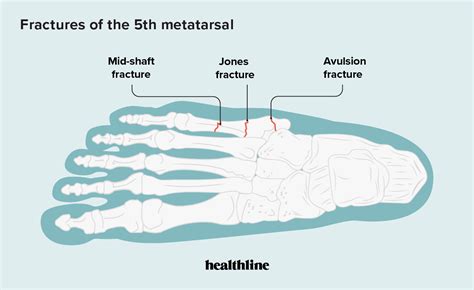Intro
Learn about the causes, symptoms, and treatment options for a 5th metatarsal break, a common foot fracture. Discover how a Jones fracture or avulsion fracture occurs, and recognize symptoms like pain, swelling, and bruising. Understand treatment options, including orthotics, casting, and surgery, to ensure proper healing and prevent complications.
The 5th metatarsal bone, located on the outside of the foot, plays a crucial role in our balance and movement. However, it is also prone to fractures, which can be quite painful and debilitating. A 5th metatarsal break, also known as a Jones fracture, can occur due to various reasons, and it's essential to understand its causes, symptoms, and treatment options to ensure proper recovery.
In this article, we will delve into the world of 5th metatarsal fractures, exploring their causes, symptoms, and treatment options. Whether you're an athlete or simply someone who enjoys staying active, understanding this common injury can help you take preventive measures and seek proper treatment if you experience a break.
What is a 5th Metatarsal Break?
A 5th metatarsal break is a fracture that occurs in the long, thin bone on the outside of the foot, known as the 5th metatarsal bone. This bone connects the little toe to the heel and plays a vital role in our balance and movement. The fracture typically occurs at the base of the bone, near the joint that connects the 5th metatarsal to the cuboid bone.

Causes of a 5th Metatarsal Break
A 5th metatarsal break can occur due to various reasons, including:
- Overuse or repetitive stress: Activities that involve repetitive stress on the foot, such as running or dancing, can cause a 5th metatarsal break.
- Trauma: A sudden, severe injury, such as a fall or a direct blow to the foot, can cause a 5th metatarsal break.
- Poor foot biomechanics: Abnormalities in the way the foot functions, such as overpronation or flat feet, can increase the risk of a 5th metatarsal break.
- Weakened bones: Conditions such as osteoporosis or bone tumors can weaken the bones, making them more susceptible to fractures.
Symptoms of a 5th Metatarsal Break
The symptoms of a 5th metatarsal break can vary depending on the severity of the fracture. Common symptoms include:
- Pain: Pain is the most common symptom of a 5th metatarsal break, which can range from mild to severe.
- Swelling: Swelling and bruising may occur in the affected area.
- Difficulty walking: A 5th metatarsal break can make it challenging to walk or bear weight on the affected foot.
- Limited mobility: The fracture can cause limited mobility in the foot and ankle.
Treatment Options for a 5th Metatarsal Break
The treatment options for a 5th metatarsal break depend on the severity of the fracture and the individual's overall health. Common treatment options include:
- Immobilization: A cast or walking boot may be used to immobilize the foot and allow the fracture to heal.
- Pain management: Pain relief medications, such as acetaminophen or ibuprofen, may be prescribed to manage pain and discomfort.
- Physical therapy: Physical therapy may be recommended to improve mobility and strength in the foot and ankle.
- Surgery: In severe cases, surgery may be necessary to repair the fracture and promote healing.

Recovery Time for a 5th Metatarsal Break
The recovery time for a 5th metatarsal break can vary depending on the severity of the fracture and the individual's overall health. Generally, it can take several weeks to several months for the fracture to heal completely.
- Mild fractures: Mild fractures may take 6-8 weeks to heal.
- Moderate fractures: Moderate fractures may take 8-12 weeks to heal.
- Severe fractures: Severe fractures may take 3-6 months to heal.
Preventing a 5th Metatarsal Break
While it's not possible to completely prevent a 5th metatarsal break, there are steps you can take to reduce your risk:
- Wear proper footwear: Wearing shoes that fit properly and provide adequate support can help reduce the risk of a 5th metatarsal break.
- Stretch and strengthen: Stretching and strengthening exercises can help improve flexibility and strength in the foot and ankle.
- Use orthotics: Orthotics, such as shoe inserts or arch supports, can help redistribute pressure and reduce stress on the foot.

Conclusion
A 5th metatarsal break can be a painful and debilitating injury, but with proper treatment and care, it's possible to make a full recovery. By understanding the causes, symptoms, and treatment options for a 5th metatarsal break, you can take steps to prevent this common injury and ensure a speedy recovery if you do experience a break.
We hope this article has provided you with valuable information about 5th metatarsal breaks. If you have any questions or concerns, please don't hesitate to comment below or share this article with others who may benefit from this information.
What is the most common cause of a 5th metatarsal break?
+The most common cause of a 5th metatarsal break is repetitive stress or overuse, often seen in athletes or individuals who engage in activities that involve running or jumping.
How long does it take for a 5th metatarsal break to heal?
+The recovery time for a 5th metatarsal break can vary depending on the severity of the fracture, but generally, it can take several weeks to several months for the fracture to heal completely.
Can I prevent a 5th metatarsal break?
+While it's not possible to completely prevent a 5th metatarsal break, you can reduce your risk by wearing proper footwear, stretching and strengthening your foot and ankle, and using orthotics if necessary.
